

Speedtalk. Examples of Speedtalk[edit] Two untranslated conversations appear in the story: "œnɪe ʀ ħøg rylp" "nU""tsʉmaeq?
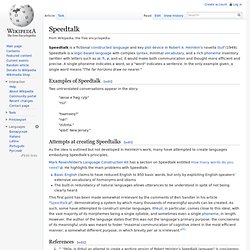
" "nø! " "zUlntsɨ. " "ɨpbitʹ New Jersey. " Attempts at creating Speedtalks[edit] As the idea is outlined but not developed in Heinlein's work, many have attempted to create languages embodying Speedtalk's principles. Mark Rosenfelder's Language Construction Kit has a section on Speedtalk entitled How many words do you need?. Basic English claims to have reduced English to 850 basic words, but only by exploiting English-speakers' extensive vocabulary of homonyms and idiomsThe built-in redundancy of natural languages allows utterances to be understood in spite of not being clearly heard This first point has been made somewhat irrelevant by the comments of Ben Sandler in his article "Speedtalk", demonstrating a system by which many thousands of meaningful sounds can be created.
References[edit] Basic English. Basic English is an English-based controlled language created by linguist and philosopher Charles Kay Ogden as an international auxiliary language, and as an aid for teaching English as a second language.
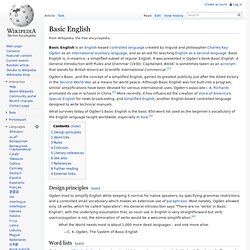
Basic English is, in essence, a simplified subset of regular English. It was presented in Ogden's book Basic English: A General Introduction with Rules and Grammar (1930). Capitalised, BASIC is sometimes taken as an acronym that stands for British American Scientific International Commercial.[1] Ogden's Basic, and the concept of a simplified English, gained its greatest publicity just after the Allied victory in the Second World War as a means for world peace. Although Basic English was not built into a program, similar simplifications have been devised for various international uses. What survives today of Ogden's Basic English is the basic 850-word list used as the beginner's vocabulary of the English language taught worldwide, especially in Asia.[3] Design principles[edit] Rules[edit] E-Prime. Some scholars advocate using E-Prime as a device to clarify thinking and strengthen writing.[1] For example, the sentence "the film was good" could not be expressed under the rules of E-Prime, and the speaker might instead say "I liked the film" or "the film made me laugh".
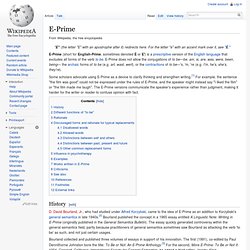
The E-Prime versions communicate the speaker's experience rather than judgment, making it harder for the writer or reader to confuse opinion with fact. History[edit] D. David Bourland, Jr., who had studied under Alfred Korzybski, came to the idea of E-Prime as an addition to Korzybski's general semantics in late 1940s.[2] Bourland published the concept in a 1965 essay entitled A Linguistic Note: Writing in E-Prime (originally published in the General Semantics Bulletin).
The essay quickly generated controversy within the general semantics field, partly because practitioners of general semantics sometimes saw Bourland as attacking the verb 'to be' as such, and not just certain usages. Rationale[edit] Most common words in English. The Reading Teachers Book of Lists claims that the first 25 words make up about one-third of all printed material in English, and that the first 100 make up about one-half of all written material.[4] Source: [1] Parts of speech Nouns timepersonyearwaydaythingmanworldlifehandpartchildeyewomanplaceworkweekcasepointgovernmentcompanynumbergroupproblemfact Verbs behavedosaygetmakegoknowtakeseecomethinklookwantgiveusefindtellaskworkseemfeeltryleavecall Adjectives goodnewfirstlastlonggreatlittleownotheroldrightbighighdifferentsmalllargenextearlyyoungimportantfewpublicbadsameable Prepositions toofinforonwithatbyfromupaboutintooverafterbeneathunderabove Others theandathatIitnotheasyouthisbuthistheyhersheoranwillmyoneallwouldtheretheir Source: [1] See also References.
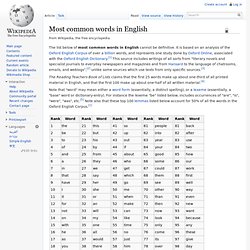
The First 100 Most Commonly Used English Words. The First 100 Most Commonly Used English Words These most commonly used words are ranked by frequency.
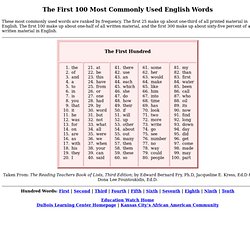
The first 25 make up about one-third of all printed material in English. The first 100 make up about one-half of all written material, and the first 300 make up about sixty-five percent of all written material in English. Taken From: The Reading Teachers Book of Lists, Third Edition; by Edward Bernard Fry, Ph.D, Jacqueline E. Kress, Ed.D & Dona Lee Fountoukidis, Ed.D. Hundred Words: First | Second | Third | Fourth | Fifth | Sixth | Seventh | Eighth | Ninth | Tenth Education Watch Home DuBois Learning Center Homepage | Kansas City’s African American Community. 50 most common english words. 50 most common english words.